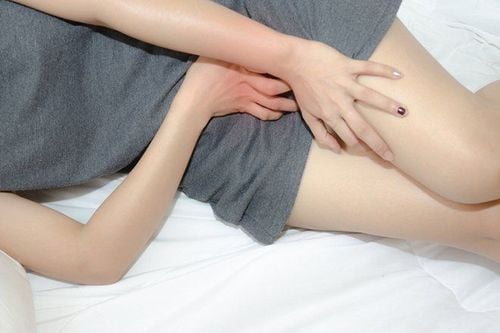This is an automatically translated article.
Postpartum engorgement is the phenomenon of hard, swollen, painful breasts due to too much breast milk. Postpartum engorgement can cause breasts to become large, full, lumpy, and tender. The swelling may reach up to the armpit and the veins on the surface of the breast may become more visible.1. Causes of postpartum engorgement
Engorgement is the result of increased blood flow in your breasts in the days after giving birth. The increased blood flow helps your breasts make more milk, but it can also cause pain and discomfort.Milk production may not occur until 3-5 days after birth. Postpartum engorgement may occur for the first time in the first week or two after giving birth. It can also recur at any time if you continue to breastfeed.
In addition, certain conditions or behaviors may make you more likely to experience bloating, which is often associated with engorgement. These causes include:
Baby misses a feed Skipping a pump Creates an excess of milk to feed baby's appetite Increases formula intake between feedings, which can reduce the amount of breast milk then Weaning too quickly Feeding a sick baby Baby having difficulty latching on and sucking Do not express breast milk after birth because you are not planning to breastfeed
2. Symptoms of engorgement
Symptoms of engorgement will vary from person to person. However, when the breast is engorged, you may feel:The breast is hard or tight. The chest is soft or warm to the touch. The chest is heavy or full. The breast is lumpy. The breast is swollen The swelling may be on only one breast or may be present. can happen on both sides. Swelling may also extend up the breast and into the nearby armpit. The veins that run under the skin of the breast may become more visible to the naked eye. This is the result of increased blood flow as well as the tension of the skin on the veins.
Some people with lactation may experience mild fever and fatigue in the first few days of lactation. This condition is sometimes called “milk fever.” You can continue to breastfeed if you have a fever. However, you should inform your doctor about an increase in temperature. That's because some breast infections can also cause fever, and these infections need to be treated before they get worse.
For example, mastitis is an infection that causes inflammation of the breast tissue. The most common cause is milk getting stuck in the breast. Untreated mastitis can lead to complications such as a collection of pus in a blocked milk duct.
Report fever and any other symptoms you have recently experienced to your doctor. They will likely watch for signs of illness or infection so you can seek treatment right away.

Một số người bị căng sữa có thể bị sốt nhẹ và mệt mỏi trong những ngày đầu tiết sữa
3. Complications of engorgement
The engorgement can cause a number of complications as follows:Poor latch on: If your breast is too full and hard, the nipple may be flat. Flat nipples and hard breasts make it difficult for your baby to get the nipple into his mouth. Decreased breast milk supply: If swelling doesn't go away and your baby can't latch on, breast milk will not come out. While breast milk is still inside your breasts, it doesn't stimulate the production of more breast milk, which can jeopardize your milk supply. You may also experience a lack of milk due to overuse of cold compresses. Poor weight gain: If your baby is having trouble latching on to your breast, he may not be getting enough breast milk to gain weight steadily. Increased pressure on breast milk flow: Pressure from milk storage in the breasts can lead to an overactive lactation reflex and cause breast milk to flow out very quickly. A heavy discharge or a rapid flow of milk can cause your baby to choke and swallow too much air when he is trying to swallow breast milk. Refusing to breastfeed: Your baby may be frustrated because it is difficult to latch on to the breast, not getting enough breast milk, or the milk flows very quickly. These problems commonly associated with engorgement can lead to babies refusing to breastfeed. Other breast problems: Breast engorgement can lead to other breast problems including sore nipples, milk discharge, blocked milk ducts, and mastitis. Early weaning: Many women leave the hospital within a few days of giving birth, so postpartum engorgement often begins at home. As this condition can be painful for the mother and makes it difficult for the baby to latch on and breastfeed, it is a common cause of early weaning.

Con bạn có thể chán nản vì khó ngậm để bắt vú, không bú đủ sữa mẹ hoặc sữa chảy rất nhanh
4. How to reduce engorgement after giving birth?
Whatever the cause, engorgement and engorgement can be painful. Here are some ways that you can do the treatment at home:Breastfeed frequently: Breastfeed frequently, at least every 1 to 3 hours throughout the day and night. Feed your baby for as long as you like, but at least 20 minutes at a time. If you find your baby drowsy, wake him up for a feed. Use hand expressing or a breast pump to express a small amount of breast milk before each feeding. This will help relieve tightness, soften your breast, and make it easier for your baby to latch on to your nipple. Massage your breast as your baby feeds to help push more milk to your baby. After each feeding, place a cold compress on the breast to help reduce pain and swelling. Change breastfeeding positions so that your baby gets all the milk from your breast areas. Talk to your doctor about taking an over-the-counter pain reliever like Tylenol or Motrin to help reduce pain and inflammation. Feed your baby from one side only during a feeding to help drain all of the milk on that side. After that, start feeding on the opposite side. Do not give your baby formula or water between feedings. Your baby will take less breast milk when it's time to feed, and you're more likely to experience engorgement. Take a warm bath or apply a warm compress to your breasts just before breastfeeding. However, you should not apply heat to your breasts between feedings as it can make swelling worse. Rest much. Watch for signs of leaking milk, blocked milk ducts, or breast infection. If you are weaning your baby, try weaning at a slower rate. If you wean your baby gradually, you may not experience engorgement at all.

Bạn không nên cho trẻ uống sữa công thức giữa các lần cho con bú bởi trẻ có thể bú ít đi
5. How to prevent engorgement after giving birth
You can't prevent engorgement in the first few days after giving birth, until your body knows how to regulate milk production.However, you can prevent future episodes of engorgement with the following tips and techniques:
Breastfeed or pump regularly. Your body makes milk regularly, regardless of your breastfeeding schedule. Feed your baby at least every one to three hours. Pump if your baby is not hungry or you are away. Use ice packs to reduce supplies. In addition to cooling and soothing inflamed breast tissue, ice and cold compresses can help reduce milk supply. That's because cool packs turn off the "reduced production" signal in your breasts, which signals your body to make more milk. Remove a small amount of breast milk. If you need to relieve pressure, you can express milk by hand or pump with a pump. However, do not smoke or squeeze too much. It can backfire on you and your body may end up trying to make more milk to make up for the milk you just eliminated. Wean breast milk slowly. If you wean your baby too quickly, your weaning plan could backfire, leaving your breasts with too much milk. Wean your baby slowly so your body can adjust to the reduced need. If you're not breastfeeding, you can wait for your breast milk to stop. Over the next few days, your body will understand that it will no longer need to produce milk and the supply will gradually decrease, which will stop engorgement. Do not express or pump milk. Because by continuing to express or pump, you are signaling to your body that it needs to continue producing milk and you may prolong the discomfort of engorgement. Vinmec International General Hospital is the address for examination, treatment and prevention of many diseases, including Obstetrics and Gynecology. Therefore, if after giving birth, the mother encounters difficulties in taking care of her children, recovering her health, worrying about postpartum nutrition, cracked nipples or engorged milk.. may come. Vinmec to visit and get the best advice from doctors. With the dedication and enthusiasm of the medical team, modern facilities will definitely make you satisfied.
Please dial HOTLINE for more information or register for an appointment HERE. Download MyVinmec app to make appointments faster and to manage your bookings easily.
Reference sources: babycenter.com, healthline.com, verywellfamily.com












